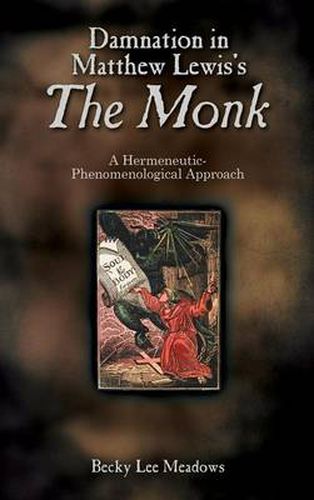Readings Newsletter
Become a Readings Member to make your shopping experience even easier.
Sign in or sign up for free!
You’re not far away from qualifying for FREE standard shipping within Australia
You’ve qualified for FREE standard shipping within Australia
The cart is loading…






This title is printed to order. This book may have been self-published. If so, we cannot guarantee the quality of the content. In the main most books will have gone through the editing process however some may not. We therefore suggest that you be aware of this before ordering this book. If in doubt check either the author or publisher’s details as we are unable to accept any returns unless they are faulty. Please contact us if you have any questions.
When nineteen-year-old Matthew Lewis crafted The Monk in 1796, he had no idea what hideous progeny he had created. The text plagued Lewis throughout his life to the point where he earned the nickname Monk Lewis, symbolic of criticism he and the text received equating Lewis directly with the ideas in his infamous gothic novel. The Monk rose to the pinnacle of popularity in an England consumed by its love for Gothic romances and enswathed in the language of political, social, and religious turmoil. In addition, Lewis’s novel has endured centuries of criticism to become part of the twenty-first century’s love affair with the Gothic. Elements in Lewis’s novel have spoken to humankind across the ages, primarily through his principle character, the fallen monk, Ambrosio. Why do The Monk and Ambrosio enwrap imaginations in the dichotomy between appeal and repulsion? What does Ambrosio experience in his mental and physical Lifeworlds as he catapults himself into damnation in the text, and what can humankind appropriate from his fall? This book takes a new approach to literary studies of The Monk by turning hermeneutic phenomenology in a new direction - into the minds of the characters themselves. The reader enters the mind of Ambrosio and experience the world and the symbols surrounding him, including his intersubjective constitution with other characters, as he experiences them. While applying phenomenology to a fictive text is not new, focusing hermeneutic phenomenology exclusively on the consciousness of the characters in a literary text is. The author takes this bold step thoughtfully and analytically, explaining step by step how Ambrosio takes himself down a path to damnation in his own consciousness before Satan ever throws him off of a mountain, in effect explaining how salvation for Ambrosio is impossible by the end of the novel. While previous approaches have analyzed the reader’s experience through the lens of phenomenology, this work examines a character’s experience through the lens of hermeneutic-phenomenology, analyzing symbols present in the monk’s consciousness and how they affect his mental path to damnation, as opposed to analyzing the reader’s experience through that same lens. By moving a layer deeper than traditional approaches, this work opens new realms of possibility in literary criticism.
$9.00 standard shipping within Australia
FREE standard shipping within Australia for orders over $100.00
Express & International shipping calculated at checkout
Stock availability can be subject to change without notice. We recommend calling the shop or contacting our online team to check availability of low stock items. Please see our Shopping Online page for more details.
This title is printed to order. This book may have been self-published. If so, we cannot guarantee the quality of the content. In the main most books will have gone through the editing process however some may not. We therefore suggest that you be aware of this before ordering this book. If in doubt check either the author or publisher’s details as we are unable to accept any returns unless they are faulty. Please contact us if you have any questions.
When nineteen-year-old Matthew Lewis crafted The Monk in 1796, he had no idea what hideous progeny he had created. The text plagued Lewis throughout his life to the point where he earned the nickname Monk Lewis, symbolic of criticism he and the text received equating Lewis directly with the ideas in his infamous gothic novel. The Monk rose to the pinnacle of popularity in an England consumed by its love for Gothic romances and enswathed in the language of political, social, and religious turmoil. In addition, Lewis’s novel has endured centuries of criticism to become part of the twenty-first century’s love affair with the Gothic. Elements in Lewis’s novel have spoken to humankind across the ages, primarily through his principle character, the fallen monk, Ambrosio. Why do The Monk and Ambrosio enwrap imaginations in the dichotomy between appeal and repulsion? What does Ambrosio experience in his mental and physical Lifeworlds as he catapults himself into damnation in the text, and what can humankind appropriate from his fall? This book takes a new approach to literary studies of The Monk by turning hermeneutic phenomenology in a new direction - into the minds of the characters themselves. The reader enters the mind of Ambrosio and experience the world and the symbols surrounding him, including his intersubjective constitution with other characters, as he experiences them. While applying phenomenology to a fictive text is not new, focusing hermeneutic phenomenology exclusively on the consciousness of the characters in a literary text is. The author takes this bold step thoughtfully and analytically, explaining step by step how Ambrosio takes himself down a path to damnation in his own consciousness before Satan ever throws him off of a mountain, in effect explaining how salvation for Ambrosio is impossible by the end of the novel. While previous approaches have analyzed the reader’s experience through the lens of phenomenology, this work examines a character’s experience through the lens of hermeneutic-phenomenology, analyzing symbols present in the monk’s consciousness and how they affect his mental path to damnation, as opposed to analyzing the reader’s experience through that same lens. By moving a layer deeper than traditional approaches, this work opens new realms of possibility in literary criticism.